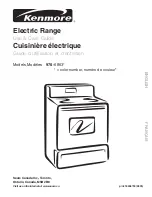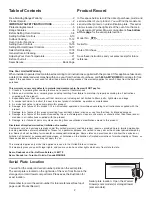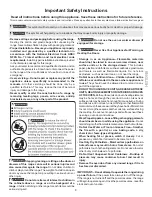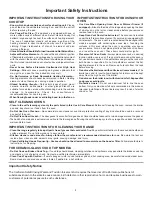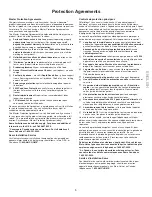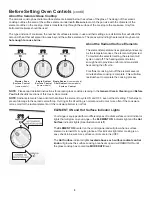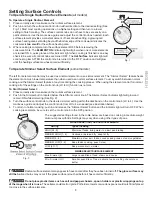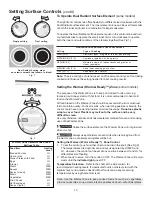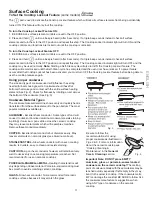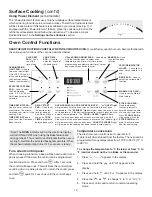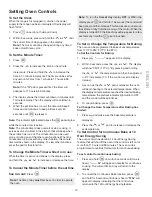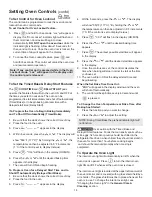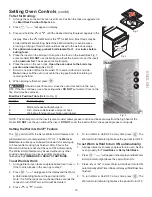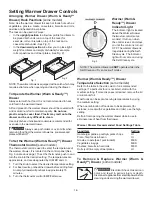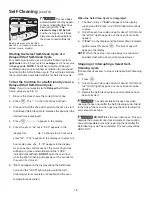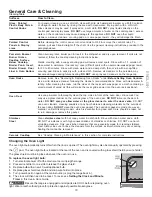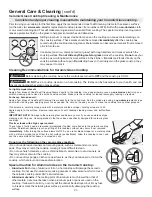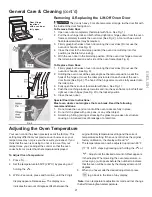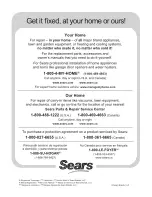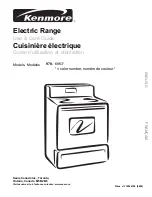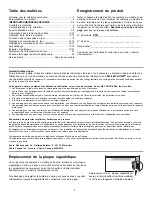
11
ENGLISH
Cookware Material Types
The cookware material determines how evenly and quickly heat is
transferred from the surface element to the pan bottom. The most
popular materials available are:
ALUMINUM -
Excellent heat conductor. Some types of food will
cause it to darken (Anodized aluminum cookware resists staining
& pitting). If aluminum pans slide across the ceramic cooktop,
they may leave metal marks which will resemble scratches.
Remove these marks immediately.
COPPER -
Excellent heat conductor but discolors easily. May
leave metal marks on ceramic glass (see Aluminum above).
STAINLESS STEEL -
Slow heat conductor with uneven cooking
results. Is durable, easy to clean and resists staining.
CAST IRON -
A poor heat conductor however will retain heat very
well. Cooks evenly once cooking temperature is reached. Not
recommended for use on ceramic cooktops.
PORCELAIN-ENAMEL on METAL -
Heating characteristics will
vary depending on base material. Porcelain-enamel coating must
be smooth to avoid scratching ceramic cooktops.
GLASS -
Slow heat conductor. Not recommended for ceramic
cooktop surfaces because it may scratch the glass.
Using proper cookware
Fig. 3
To Set the Cooktop Lockout Feature
(some models)
The
pad is used to activate the Cooktop Lockout feature which will lock all surface elements from being accidentally
turned ON. This feature will only lock the cooktop.
To turn the Cooktop Lockout Feature ON:
1. BE SURE ALL surface element controls are set to the OFF position.
2. Press and hold
until one beep is heard (after 3 seconds). If a triple beep sounds instead, check all surface
elements and turn them to the OFF position and repeat this step. The Cooktop Locked indicator light will turn ON and the
cooktop controls and functions are locked out until the cooktop is unlocked.
To turn the Cooktop Lockout Feature OFF:
1. BE SURE ALL surface element controls are set to the OFF position.
2. Press and hold
until one beep is heard (after 3 seconds). If a triple beep sounds instead, check all surface
elements and turn them to the OFF position and repeat this step. The Cooktop Locked indicator light will turn OFF and the
cooktop may be used normally.
Note:
Starting a Self-Clean cycle will also turn ON the Cooktop Lockout feature. The
cooktop will remain locked until the Self-Clean cycle has completed and the oven door has unlocked. If a power failure
occurs after the Cooktop Lockout has been activated, you must turn OFF the Cooktop Lockout feature before being able to
use the cooktop features again.
Surface Cooking
Fig. 2
The size and type of cookware used will influence the setting
needed for best cooking result
s.
Cookware should have flat
bottoms that make good contact with the entire surface heating
element (See Fig. 2). Check for flatness by rotating a ruler across
the bottom of the cookware (See Fig. 3).
Be sure to follow the
recommendations for using
proper cookware as illustrated in
Figs. 2 & 3. For more information
about the ceramic cooktop see
“Cooktop Cleaning &
Maintenance” in the
General
Care & Cleaning
section.
Important Note: DO NOT place EMPTY
aluminum, glass or porcelain-enamel coated
cookware on the ceramic cooktop!
The melting
point of cookware made with these materials may be
reached quickly especially if left empty & they may
bond to the ceramic cooktop. If the cookware melts
it WILL damage the cooktop! BE SURE to follow ALL
the cookware manufacturer’s suggestions when
using ANY type of cookware on the ceramic
cooktop.
Содержание 970-6863 Series
Страница 23: ...23 ENGLISH Notes ...
Страница 24: ......
Страница 47: ...23 FRANÇAIS Notes ...
Страница 48: ......

